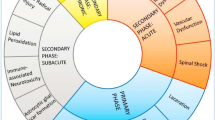Summary
We have studied 70 patients who underwent surgical decompression with or without fusion for cervical and/or thoracic myelopathy to assess the value of spinal cord evoked potentials (SCEP). The 70 patients included 42 with cervical spondylotic myelopathy, 10 with ossification of the posterior longitudinal ligament of the cervical spine and 18 with thoracic ligamentous ossification. Abnormal SCEP occurred in 88% of the patients with cervical myelopathy. Early recovery in intra- and postoperative SCEP was associated with a better result. The severity of myelopathy correlated significantly with an abnormal SCEP in thoracic myelopathy. SCEP may reflect the severity of disease, and early recovery of intraoperative SCEP may also predict neurological improvement.
Résumé
Nous avons étudié 70 patients ayant eu une décompression chirurgicale avec ou sans fusion pour une myélopathie cervicale et/ou dorsale afin d'évaluer l'utilité des potentiels évoqués de la moelle épinière (PEME). Quarante-deux patients avaient une myélopathie spondylosique cervicale, 10 une ossification du ligament longitudinal postérieur cervical et 18 une ossification ligamentaire dorsale. Des PEME anormaux ont été observés chez 88% des malades présentant une myélopathie cervicale. Le rétablissement rapide des PEME per et post-opératoires a été suivi des résultats les meilleurs. Dans la myélopathie dorsale une corrélation significative a été mise en évidence entre la gravité de la myélopathie et les PEME anormaux. Les PEME pourraient refléter la gravité de la maladie et une récupération per-opératoire rapide des PEME pourrait également faire prévoir une amélioration neurologique.
Similar content being viewed by others
References
Baba H, Shima I, Tomita K, Umeda S, Sawada Y (1985) Clinical usefulness of spinal cord evoked potentials. In: J Schramm, SJ Jones (eds) Spinal cord monitoring. Springer, Berlin, Heidelberg, New York, pp 245–249
Baba H, Tomita K, Umeda S (1988) Clinical study of spinal cord evoked potentials. In: TB Ducker, RH Brown (eds) Neurophysiology and standards of spinal cord monitoring. Springer, New York Berlin Heidelberg, pp 216–221
Baba H, Nagata S, Kawahara N, Tomita K, Imura S (1992) Spinal somatosensory evoked potentials in compression and distraction injury. 59th Annual Meeting of American Academy of Orthopaedic Surgeons, Washington DC
Baba H, Tomita K, Kawahara N (1992) Spinal cord monitoring: diagnosis and prognostic evaluation of cervical myelopathy. J Jpn Orthop Assoc 66: S 219
Ben-David B, Haller G, Taylor P (1988) Discrepancy between intra-operative SSEPs and post-operative function. J Neurosurg 69: 450–454
Boachie-Adjei O, Bradford DS (1991) Vertebral column resection and arthrodesis for complex spinal deformities. J Spinal Disord 4: 193–202
Dawson EG, Sherman JE, Kanim LEA, Nuwer MR (1991) Spinal cord monitoring: results of the Scoliosis Research Society and European Spinal Deformity Society survey. Spine 16: S 361–365
Jacobson GP, Tew JM (1987) Intra-operative evoked potential monitoring. J Clin Neurophysiol 4: 145–176
Katz RT, Toleikis RJ, Knuth AE (1991) Somatosensory-evoked potentials and dermatomal-evoked potentials are not clinically useful in the prognostication of acute spinal cord injury. Spine 16: 730–735
Kikuchi Y, Baba H, Kawahara N (1991) Experience of diagnosis of thoracic myelopathy using spinal cord evoked potentials. In: K Shimoji, T Kurokawa, T Tamaki, WD Willis Jr (eds) Spinal cord monitoring and electrodiagnosis. Springer, Berlin Heidelberg New York, pp 461–471
Kotani H, Senzoku F, Hattori S, Moritake A, Hara T, Omote K (1992) Evaluation of cervical cord function using spinal evoked potentials from surface electrode. Spine 17: 339–344
Nash CL Jr, Brown RH (1989) Current concepts review: spinal cord monitoring. J Bone Joint Surg [Am] 71: 627–630
Owen JH, Radberg AM, Spar-Holland L, Bridwell KH, Keppler L, Steffee AD (1991) Clinical correlation between degenerative spine disease and dermatomal somatosensory evoked potentials. Spine 16: S 201–205
Schramm J, Krause R, Shigeno T, Brock M (1983) Experimental investigation on the spinal cord evoked injury potentials. J Neurosurg 59: 485–492
Shinomiya K, Okamoto A, Komori H, Matsuoka T, Yoshida H, Muto N, Furuya K (1990) Prognosticating study for cervical myelopathy using evoked spinal cord potentials. Spine 15: 1053–1057
Tomita K, Nomura S, Umeda S, Baba H (1988) Cervical laminoplasty to enlarge the spinal canal in multilevel ossification of the posterior longitudinal ligament with myelopathy. Arch Orthop Trauma Surg 107: 148–153
Tomita K, Kawahara N, Baba H, Kikuchi Y, Nishimura H (1990) Circumspinal decompression for thoracic myelopathy due to ossification of the posterior longitudinal ligament and ligamentum flavum. Spine 15: 1114–1120
Author information
Authors and Affiliations
Additional information
Reprint requests to: H. Baba
Rights and permissions
About this article
Cite this article
Baba, H., Kawahara, N., Tomita, K. et al. Spinal cord evoked potentials in cervical and thoracic myelopathy. International Orthopaedics 17, 82–86 (1993). https://doi.org/10.1007/BF00183547
Issue Date:
DOI: https://doi.org/10.1007/BF00183547




